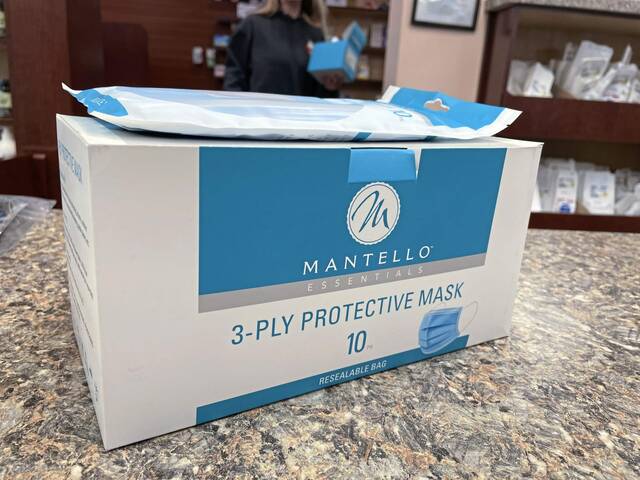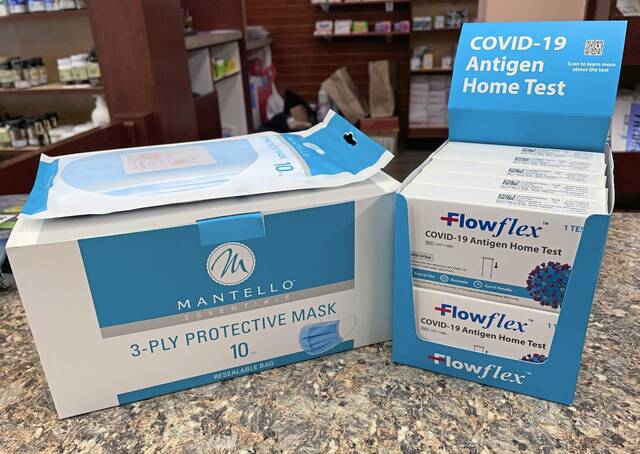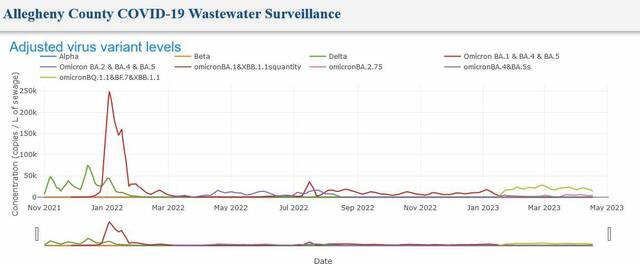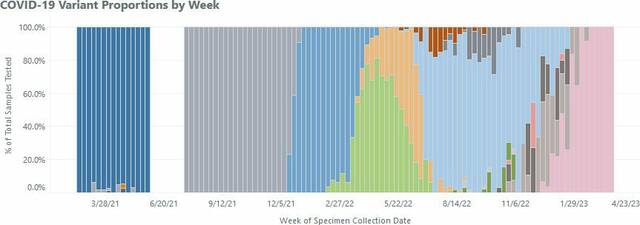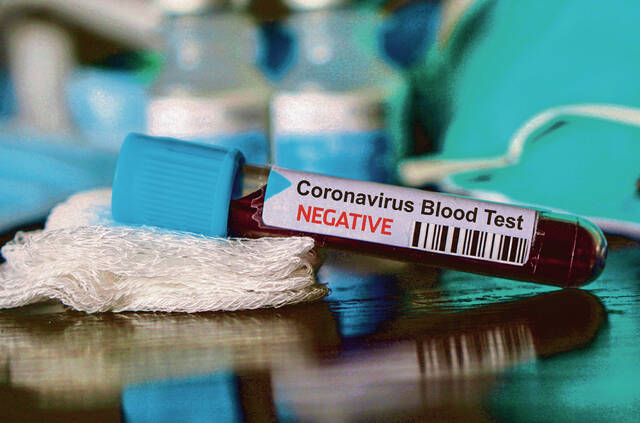As covid health emergency ends, tracking methods change, too
When home covid tests first became available, they were flying off the shelves and customers often struggled to find them.
Now at Mainline Pharmacy’s Harrison City location, home covid tests are available, but kept behind the counter.
Erica McClain, pharmacy tech, said people come in to ask for them “every once in a while, but not a whole lot.”
Likewise, in the first weeks and months of the pandemic, covid-19 case reports from health care services and news media websites bobbed up and down each day and served as barometers for the spread of the disease. Public officials and business leaders used this data to make decisions ranging from closing schools and businesses to issuing work-from-home orders.
Three years later, with the federal public health emergency expiring Thursday, the standard for tracking covid may have become obsolete, health experts say. That’s, in part, because of ubiquitous at-home test kits and a general reluctance by the public to report positive test results to health officials, leaving data that doesn’t reflect the entire picture.
Instead, the future of covid tracking will likely be a combination of hospital-based testing and medical laboratory testing of specimens from public wastewater treatment plants. Labs can detect covid in samples of sewage, a method that doesn’t require individual people to submit results from home tests.
“The average person hasn’t been looking at covid numbers. The person on the street, I’m sure they don’t know what the covid prevalence is,” said Western Pennsylvania-based infectious disease expert Dr. Amesh Adalja, a senior scholar at the Johns Hopkins Center for Health Security. “These data have not been meaningful for a long time because of home tests. When home tests became available, wastewater became the more important metric to look at. (It) is a much more inclusive metric because it is not dependent on testing of any sort.”
According to the National Institutes of Health, testing of water processed at sewage treatment facilities is conducted to track covid in communities.
In Allegheny County, wastewater covid tracking is conducted two to three times weekly at six sites, according to LuAnn Brink, chief epidemiologist at the county health department. Samples of wastewater are sent to the county’s Public Health Lab. The county has used wastewater tracking to monitor covid since October 25, 2021, and found it “very useful” during the surge period for the omicron variant, she said.
Tracking cases
Brink said information about positive tests, hospitalizations and deaths at the county level will continue to be available after May 11, as it has since the pandemic started. However, some datasets may be more useful than others.
“We were one of the first jurisdictions with the (covid) dashboard up, and it has always contained information on the tests, hospitalizations and deaths that have occurred,” she said.
Moving forward, there may be a bigger focus on hospitalizations and deaths rather than on individual case counts, she said.
“We anticipate we will continue to provide case counts at some frequency. I don’t know exactly what that is going to look like, but with numbers going down, it is less critical to provide the frequency of information that we had previously,” she said. “We were once doing this on a daily basis, now we’re doing that on a weekly basis. … We’re shifting our focus to the hospitalizations and deaths and looking for additional resources to gather those data.”
According to Adalja, case-by-case data hasn’t been as relevant to keeping track of the virus for some time.
“Individual case counts have had less value, as we’ve seen more decoupling of individual cases from hospitalizations and death,” he said. “I think when you’re thinking about an endemic respiratory virus that’s never going to be eradicated, the focus has to be on preventing severe disease.”
Tracking hospitalizations and deaths from covid is more important than individual case counts, especially with the rise of at-home testing, Adalja said.
“The value of home tests outweighs having a day-to-day number of how many cases are occurring,” he said. “When you’re talking about a virus that is always going to be going thorough ups and downs, (hospitalizations) are more important. … The number of individual cases of a ubiquitous respiratory virus are, to me, not that valuable.”
Wastewater tracking
Adalja expects wastewater monitoring to be expanded to track other health concerns, such as the flu, norovirus, drug-resistant bacteria and polio. It may become a bigger part of public health messaging, like a “weather forecast” for disease, he said.
Brink agreed, adding that the tracking program will continue to monitor covid variants.
“They are running sequencing on it to find out what variants are occurring in the wastewater, and that is part of our dashboard as well,” she said. “We don’t have to worry about PCR tests or home tests or anything (with wastewater testing).”
Westmoreland County, like some other counties in the state, does not have a health department. Some wastewater tracking data is available through the National Wastewater Surveillance System (NWSS), which is run by the federal Centers for Disease Control and Prevention.
The Municipal Authority of Westmoreland County, which serves more than 120,000 drinking water customers in a five-county region and about 25,000 wastewater customers, does not participate in the NWSS program, a spokesperson with the authority said. The authority responded to an inquiry about possibly participating in the program, but was not chosen to participate.
Samples from wastewater testing can reveal the number of virus particles per liter, the number of copies of covid variants or subvariants, and the percentage of each variant in the sample. The county also uses wastewater testing to track Enterovirus D68, a virus that can cause respiratory illness and neurological conditions.
Allegheny County’s wastewater testing is funded through an Enhancing Lab Capacity and Surveillance Grant through the federal government, Brink said. The funding runs through June 30, 2024.
The Pennsylvania Department of Health and the CDC said they expect to continue to track and report on covid and variants after May 11, though the specific approach remains to be determined.
Adalja noted there is now more tracking for covid variants than there is for the flu.
“There’s going to be variant typing going on for the foreseeable future, and the public would be alerted to any kind of concerning variant,” he said. “They may become more immune evasive or more contagious, but the ability to cause severe disease in a community that has so much immunity and access to drugs like Paxlovid is becoming increasingly less likely. … There’s always going to be a new variant going around. Evolution is never going to stop.”
Hospital cases
Allegheny Health Network infectious disease specialist Dr. Tom Walsh said the hospital system’s methods for tracking covid have shifted through the life of the pandemic.
It can sometimes be difficult to determine whether someone was admitted to the hospital specifically because of covid or whether they happen to be positive for covid when admitted, he said.
“We do a manual review to be able to tell the percentage of the hospitalizations that are due to covid versus those that are incidentally detected,” he said. “As we went on, more of the cases were incidentally found in hospitalized patients as opposed to being hospitalized due to covid.
“We still do track that and look at it for trends, and when we see upticks, we’ll do a manual review of those charts to see if we are seeing more patients who are admitted for covid.”
AHN has a real-time internal dashboard where staff can see how many people within the hospital have tested positive, he said.
“If we see someone with a positive test and (they are) on anti-covid therapy, it’s more likely they’re admitted with covid versus for a second reason,” Walsh said.
At UPMC, even if CDC data tracking changes after the end of the public health emergency, the health system will continue to track covid, said Dr. Graham Snyder, medical director of infection prevention. Providers are encouraged to test patients, especially if they are at risk of complications, he said.
UPMC keeps track of covid positive tests, hospitalizations, cases in the ICU, ventilator-level cases and any covid-related deaths. The system also tracks how many employees are out sick for covid-related reasons, he said.
“We don’t have any plans to stop watching those numbers after May 11,” he said.
Tracking today and beyond
Allegheny County tracks hundreds of different reportable conditions, according to Brink, and reports on them, typically annually. Even beyond the public health emergency date, Brink expects covid tracking and communication to continue into the future.
“Should something occur — additional variants, an increase in emergency department visits, hospitalizations or deaths — we will stay on it as we do any other disease outbreaks,” Brink said.
The difference with covid as compared to other diseases the county tracks is in how fast covid can spread and how many cases have previously been detected in a day, she said.
“We do have info on influenza that is updated on a weekly basis. I could certainly anticipate something like that happening (for covid in the future,)” she said. “(Covid) has not gone away, but it’s much less of a concern as it was three years ago or even over time, as we’ve gotten more of the population vaccinated and we have better outcomes.”
Snyder anticipates UPMC continuing to track and test for the disease as well.
“The probability of serious complications, even though most of us have had vaccinations or boosters or prior infections, it’s still having an outsized impact as far as respiratory viruses go, as far as the number of hospitalizations and deaths,” he said. “Therefore, I think it’s still very important to test for, particularly in people who have medical conditions that may leave them susceptive to serious complications.”
Testing is still useful even with home tests available because if a case gets more severe, there are treatments like Paxlovid that can help, he said.
“That’s a big part of the reason that testing will remain important because we have options for you,” he said. “Short term, I would still suggest people get tested for covid if they have symptoms of covid. If we are positive, it may not mean we need treatment, but it will give us some guidance on how to protect people around us, especially in the workplace.”
Julia Maruca is a TribLive reporter covering health and the Greensburg and Hempfield areas. She joined the Trib in 2022 after working at the Butler Eagle covering southwestern Butler County. She can be reached at jmaruca@triblive.com.
Remove the ads from your TribLIVE reading experience but still support the journalists who create the content with TribLIVE Ad-Free.

